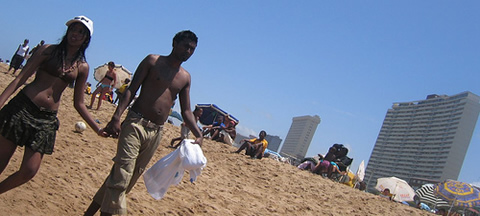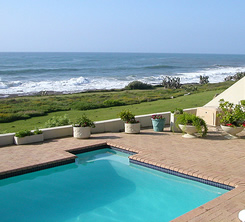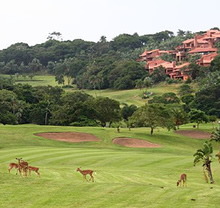South Coast

Amanzimtoti Beach situated just south of Durban
Like a proverbial comet tail the South Coast of KwaZulu/Natal trails behind the fast moving and energetic metropolis of Durban. It is a thin but concentrated strip of coastal development, squeezed largely between the Indian Ocean and the N2 freeway, and the expansive hinterland beyond that is dominated mainly by commercial sugar plantations. A recent visitor to the region from the United States described it as Southern California 50 years ago. This assessment is dynamic, because the area is under rapid evolution, and hovers now, as it seems always to have done, between local protest and over development. The South Coast has also been compared in terms of climate and general aspect to the U.S. state of Florida.
Hibiscus Coast
Styled the Hibiscus Coast, this certainly is a ubiquitous local bloom, but it competes with countless others in a region where rainfall is high, summers are hot and humid, and winters mild and sunny. The sheer volume of nurseries and garden centres tell the tale. The South Coast is a horticulturalists paradise, with large numbers of commercial producers working alongside countless retirees and escapees, who all seem to share a passion for garden colour and vivacity.
Landscape
The indigenous landscape is characterised by grassy slopes and thickly forested gullies, with a number of shallow estuaries draining into the ocean from the Drakensberg runoff. For the most part the coast is lined with extensive and exposed sandy beaches that enjoy considerable wave action. Surfers naturally gravitate to many of the more popular beaches, of which there are perhaps a dozen or more, around which is usually the most concentrated urban development.
 Beaches & Developments
Beaches & Developments
The character of the beaches and development associated with the South Coast varies depending on local usage. Just a few miles south of Durban is the holiday Mecca of Amanzimtoti, the quintessential Costa del Sol type beach development, with high rise hotels and holiday apartments that usually wipe the sunshine off the beach in the late afternoon.
As the coast stretches south, however, there are a number of similar tourist towns with varying degrees of commercialism, but none quite so bare faced as Amanzimtoti. Even the declared tourist free zones – those guarded jealously by the hordes of retirees and ‘locals’ – have a sneaky little B&B tucked away somewhere, or a chintzy little art gallery with an eye on the tourist dollar.
What to Do
The area is not a particularly renowned diving location, but plenty of diving options are available, with surfing and wave sports probably the most ubiquitous local pursuit, and many kayaking options thanks to the many deep river inlets that cut inland from the coast. Here the riparian forest ecology is rich with birdlife. Fly, estuary, shore and offshore fishing are all rewarding pursuits along the South Coast, and many local charters and tours are available.
 Mainly people come to the area to enjoy the beaches and to relax in a lively party environment. Associated with this is a somewhat strip-mall orientated commercial angle, with countless little tourist related peculiarities tucked away in odd places, and a large number of excellent restaurants, spas and holiday accommodation options.
Mainly people come to the area to enjoy the beaches and to relax in a lively party environment. Associated with this is a somewhat strip-mall orientated commercial angle, with countless little tourist related peculiarities tucked away in odd places, and a large number of excellent restaurants, spas and holiday accommodation options.
Look out for the annual winter Sardine Run…
Golf is a KwaZulu/Natal perennial, and a number of highly rated golf courses are on offer in the area.
What you will not find on the South Coast is raw and unadulterated Africa. To find it you do not have to look far – the Wild Coast is a short distance south, and inland are quite a few areas of village and communual life – but manifestly the Hibiscus Coast is not it.
Climate
As a rule the South Coast is hot and humid during the summer months, peaking in February which is widely regarded as the suicide month, while winters are cooler, dryer and much more pleasant, and can on occasions be quite cold. There is rarely an instance, however, when one finds it necessary to take refuge in a pair of long trousers, closed shoes and a fleece. Annual summer rainfall regularly exceed 1000mm, with temperatures between late November and March averaging highs of 28°C to 32°C (82°F-90°F). Average highs between June and late September reach a very agreeable 23°C to 25°C (73°F-77°F).
More information about South African weather
When to Go
There is never a bad time to visit the South Coast, although the December school holidays in South Africa witness a legendary exodus of working folk from Gauteng towards the beaches of Durban and beyond. Accommodation is booked up, the malls are heaving and the roads are congested. The upside is that the region rocks, with clubs, bars and restaurants doing a brisk, loud and lively trade. If this is not your preference then the Christmas period is one to avoid.
The winters are extremely pleasant if your interest is in general touring, but the summers are great for Watersports, beaches and enjoying the ten thousand private swimming pools, one of which is never more than ten feet away from where you are standing.
Travel Warnings
Crime: The South Coast shares the same general dangers of street crime and muggings as the rest of South Africa. Muggings are frequent, and long and lonely beach walks at any time are definitely not advisable. On the whole walking around during the day, and in busy areas, and being out and about generally, is not dangerous, but avoid walking the streets at night, and definitely do not venture out on the beach alone after dark. Seek and follow local advice on the matter of crime and general safety wherever and with whomever you go.
- Leave important documents in a safe place. All hotels, lodges and hostels offer safe lock up facilities
- Seek safety advice from you hospitality establishment wherever you are
- Avoid walking anywhere after dark, particularly in urban areas, and particularly in the CBD of any of the larger cities and towns
- Don’t leave anything of value in your car overnight
- Incidences of car hijackings in South Africa are high Always be aware of your surroundings, particularly at night
- Don’t stop on any of the freeways for more than a few minutes, and in the instance of a breakdown, call for help
Sharks: The South Coast is shark country, and it is thanks to a highly organized local Sharks Board that offshore nets are maintained and attacks subsequently rare. Be aware.
Health
AIDS: Any kind of casual sexual encounter in South Africa, as with anywhere in the world these days, is to be discouraged. South Africa has one of the highest infection rates on the planet, about 1 in 4 of the population, so obviously extra caution is necessary when visiting any destination on the sub-continent.
In most of South Africa tropical diseases are rare. Although the KwaZulu/Natal South Coast enjoys a sub-tropical climate, incidences of malaria are rare, although there lots of mosquitoes about, and repellent is a must. As a matter of policy a course of anti-malarial drugs is advisable in the province, particularly if you intend travelling further north up the coast to Maputaland.
Travel Doctor clinics are to be found in all the major centres where you can get health advice on malaria, yellow-fever, AIDS and any other tropical diseases, and acquire all the vaccinations and prophylactics necessary for your extended journey.
Tap water is usually safe to drink.
Sunburn risks are high so hats, long sleeved T-shirts and sun screen are a must.
Image: Thanks flickr – represent.co.za